Yves here. This is a wide ranging post on the rising odds of high consequence, climate-change induced events. Sobering.
By Jeff Masters, who co-founded the Weather Underground and served as its chief meteorologist and on its Board of Directors until it was sold to the Weather Company in 2012. Between 2005-2019, his Category 6 blog was one of the Internet’s most popular and widely quoted sources of extreme weather and climate change information. Originally published at Yale Climate Connections
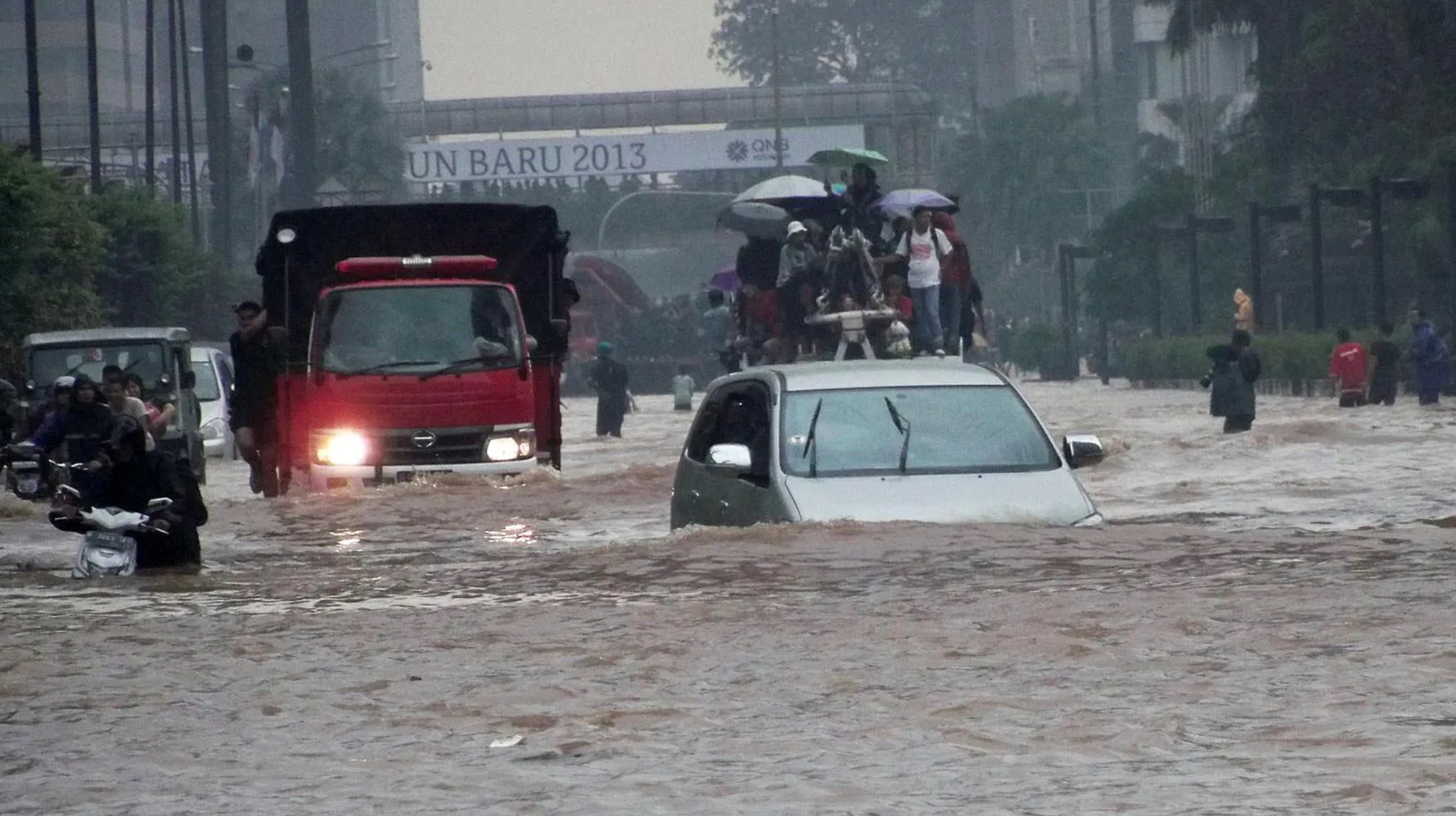
Flooding in the capital of Indonesia, Jakarta, on January 17, 2013. Sea level rise is such a major threat to the city that a new capital city for Indonesia is being built on neighboring Borneo Island. (Image credit: Voice of America)
Four times since 1900, human civilization has suffered global catastrophes with extreme impacts: World War I (40 million killed), the 1918-19 influenza pandemic (40-50 million killed), World War II (40-50 million killed), and the COVID-19 pandemic (an economic impact in the trillions, and a 2020-21 death toll of 14.9 million, according to the World Health Organization).
These are the only events since the beginning of the 20th century that meet the United Nations’s definition of global catastrophic risk (GCR): a catastrophe global in impact that kills over 10 million people or causes over $10 trillion (2022 USD) in damage.
But human activity is “creating greater and more dangerous risk” and increasing the odds of global catastrophic risk events, by increasingly pushing humans beyond nine “planetary boundaries” of environmental limits within which humanity can safely operate, warns a recent United Nations report, “Global Assessment Report on Disaster Risk Reduction – Our World at Risk: Transforming Governance for a Resilient Future” (GAR2022) and its companion paper, “Global catastrophic risk and planetary boundaries: The relationship to global targets and disaster risk reduction” (see July post, “Recklessness defined: breaking 6 of 9 planetary boundaries of safety“).
These reports, endorsed by United Nations Secretary-General António Guterres, make the case that the combined effects of disasters, economic vulnerabilities, and overtaxing of ecosystems are creating “a dangerous tendency for the world to tend toward the Global Collapse scenario. This scenario presents a world where planetary boundaries have been extensively crossed, and if GCR events have not already occurred or are in the process of occurring, then their likelihood of doing so in the future is extreme … and total societal collapse is a possibility.”
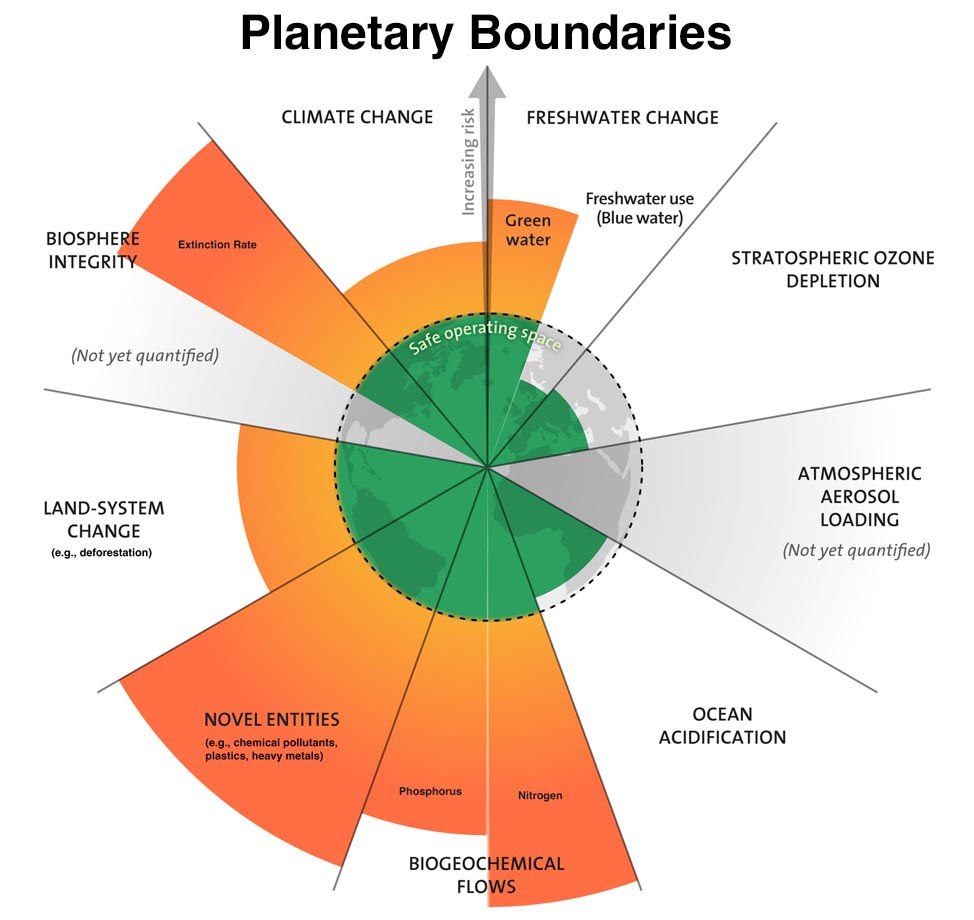
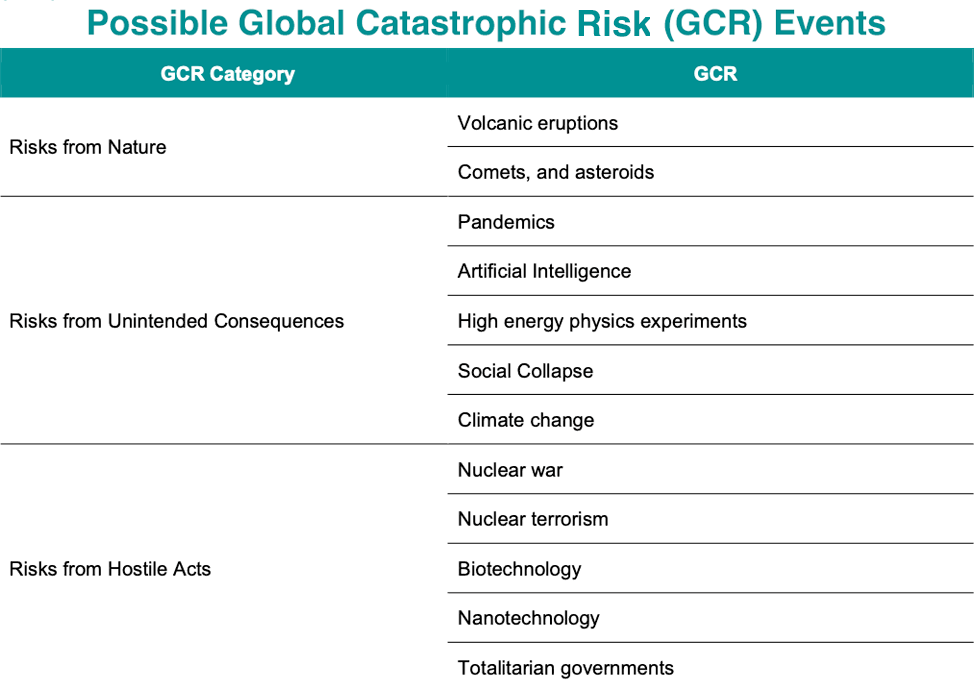
Global Catastrophic Risk (GCR) Events
Human civilization has evolved during the Holocene Era, the stability of which is now threatened by human-caused climate change. As a result, global catastrophic risk events from climate change are growing increasingly likely, the U.N. May 2022 reports conclude. There are many other potential global catastrophic risk events, both natural and human-caused (Figure 2), posing serious risks and warranting humanity’s careful consideration. But the report cautions of “large uncertainty both for the likelihood of such events occurring and for their wider impact.” (Note that there is at least one other type of Global Catastrophic Risk event the report omits: an intense geomagnetic storm. A repeat of the massive 1859 Carrington Event geomagentic storm, which might crash the electrical grid for 130 million people in the U.S. for multiple years, could well be a global catastrophic risk event.)
Five types of GCR events with increasing likelihood in a warmer climate
1) Drought
The most serious immediate global catastrophic risk event associated with climate change might well be a food-system shock caused by extreme droughts and floods hitting multiple major global grain-producing “breadbaskets” simultaneously. Such an event could lead to significant food prices spikes and result in mass starvation, war, and a severe global economic recession. This prospect exists in 2022-23, exacerbated by war and the COVID-19 pandemic.
The odds of such a food crisis will steadily increase as the climate warms. The author of this post presented one such scenario in an op-ed published in The Hill last year, and insurance giant Lloyds of London detailed another such scenario in a “food system shock” report issued in 2015. Lloyds gave uncomfortably high odds of such an event’s occurring—well over 0.5% per year, or more than a 14% chance over a 30-year period.
2) War
In his frightening book Food or War, published in October 2019, science writer Julian Cribb documents 25 food conflicts that have led to famine, war, and the deaths of more than a million people – mostly caused by drought. For example, China’s drought and famine of 1630-31 led to a revolt that resulted in the collapse of the Ming Dynasty. Another drought in China in the mid-nineteenth century led to the Taiping rebellion, which claimed 20-30 million lives.
Since 1960, Cribb says, 40-60% of armed conflicts have been linked to resource scarcity, and 80% of major armed conflicts occurred in vulnerable dry ecosystems. Hungry people are not peaceful people, Cribb argues, and ranks South Asia – India, Pakistan, Bangladesh, and Sri Lanka – as being at the most risk of future food/water availability conflicts. In particular, nuclear powers India and Pakistan have a long history of conflict, so climate change can be expected to increase the risk of nuclear war between them. A “limited” nuclear war between India and Pakistan, 100 bombs dropped on cities. would be capable of triggering a global “nuclear winter” with a death toll up to two billion, Helfand (2013) estimated.
3) Sea-level rise, combined with land subsidence
During the coming decades, it will be very difficult to avoid a global catastrophic risk event from sea-level rise, when combined with coastal subsidence from groundwater pumping, loss of river sedimentation from flood-control structures, and other human-caused effects: A moderate global warming scenario (RCP 4.5) will put $7.9-12.7 trillion dollars of global coastal assets at risk of flooding by 2100, according to a 2020 study by Kirezci et al., “Projections of global-scale extreme sea levels and resulting episodic coastal flooding over the 21st Century.” While this study did not take into account assets that inevitably will be protected by new coastal defenses to be erected, neither did it consider the indirect costs of sea-level rise from increased storm surge damage, mass migration away from the coast, salinification of fresh water supplies, and many other factors. A 2019 report by the Global Commission on Adaptation estimated that sea level rise will lead to damages of more than $1 trillion per year by 2050.
Furthermore, sea-level rise, combined with other stressors, might bring about megacity collapse – a frightening possibility with infrastructure destruction, salinification of fresh water resources, and a real estate collapse potentially combining to create a mass exodus of people, reducing the tax base of the city to the point that it can no longer provide basic services. The collapse of even one megacity might have severe impacts on the global economy, creating increased chances of a cascade of global catastrophic risk events. One megacity potentially at risk of this fate is the capital of Indonesia, Jakarta, with a population of 10 million). Land subsidence (up to two inches per year) and sea-level rise (about 1/8 inch per year) are so high in Jakarta that Indonesia currently is constructing a new capital city in Borneo. Plans call for moving 8,000 civil servants there in 2024, and eventually move 1.5 million workers from Jakarta to the new capital by 2045.
4) Pandemics
As Earth’s climate warms, wild animals will be forced to relocate their habitats and increasingly enter regions with large human populations. This development will dramatically increase the risk of a jump of viruses from animals to humans that could lead to a pandemic, according to a 2022 paper by Carlson et al. in Nature, “Climate change increases cross-species viral transmission risk.” Bats are the type of animal of most concern.
Note that in the case of the 1918-19 influenza GCR event, a separate GCR event helped trigger it: WWI, because of the mass movement of troops that spread the disease. The U.N. reports emphasize that one GCR event can trigger other GCR events, with climate change acting as a threat multiplier.
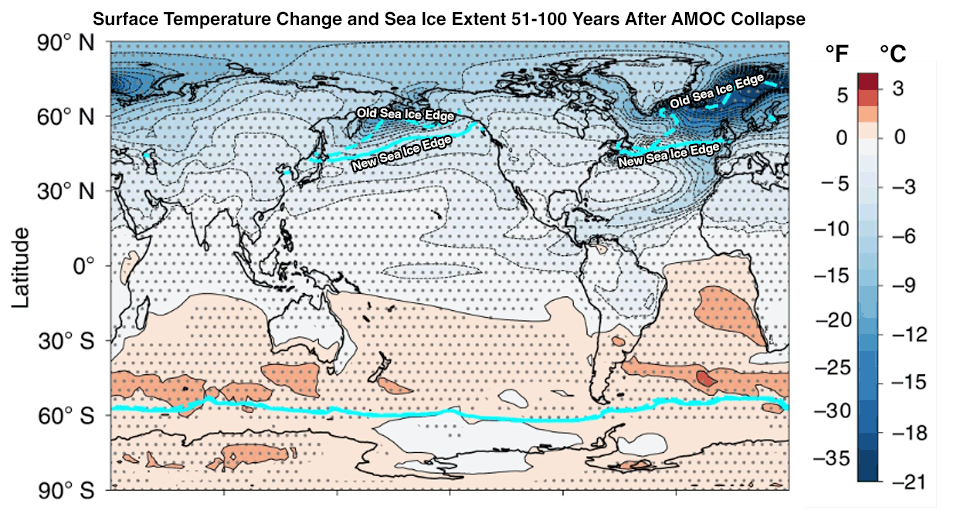
5) Ocean current changes
Increased precipitation and glacial meltwater from global warming could flood the North Atlantic with enough fresh water to slow down or even halt the Atlantic Meridional Overturning Circulation (AMOC), the ocean current system that transports warm, salty water from the tropics to the North Atlantic and sends cold water to the south along the ocean floor. If the AMOC were to shut down, the Gulf Stream would no longer pump warm, tropical water to the North Atlantic. Average temperatures would cool in Europe by three degrees Celsius (5.4°F) or more in just a few years – not enough to trigger a full-fledged ice age, but enough cooling to bring snows in June and killing frosts in July and August, as occurred in the famed 1816 “year without a summer” caused by the eruption of Mt. Tambora. In addition, shifts in the jet stream pattern might bring about a more La Niña-like climate, causing an increase in drought to much of the Northern Hemisphere, greatly straining global food and water supplies.
A study published in August 2021 looked at eight independent measures of the AMOC, and found that all eight showed early warning signs that the ocean current system may be nearing collapse. “The AMOC may have evolved from relatively stable conditions to a point close to a critical transition,” the authors wrote.
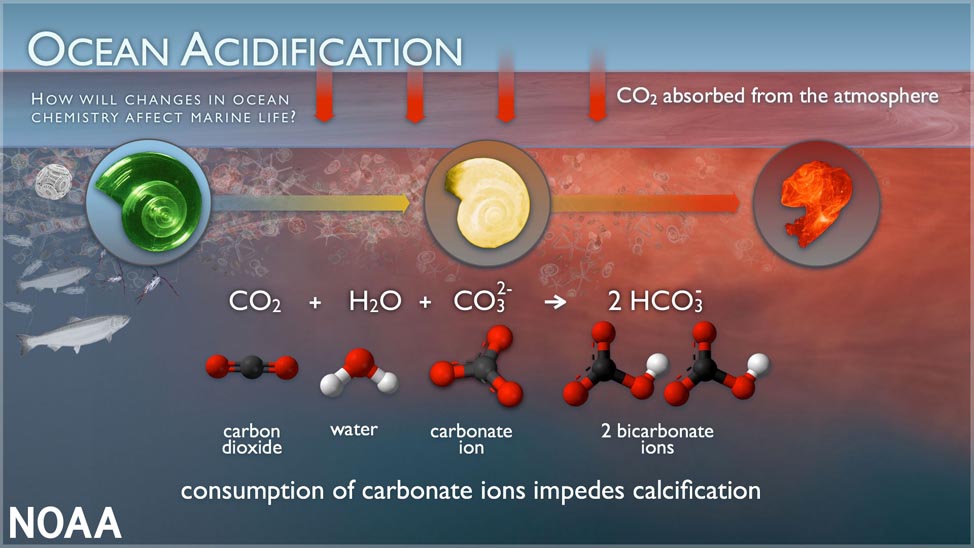
6) Ocean acidification
The increased carbon dioxide in the atmosphere is partially absorbed by the oceans, making them more acidic. Since pre-industrial times, the pH of surface ocean waters has fallen by 0.1 pH units, to 8.1 – approximately a 30 percent increase in acidity. Increased acidity is harmful to a wide variety of marine life, and acidic oceans have been linked to several of Earth’s five major extinction events through geologic time.
Under a business-as-usual emission scenario, continued emissions of carbon dioxide could make ocean pH around 7.8 by 2100. The last time the ocean pH was this low was during the middle Miocene, 14-17 million years ago. The Earth was several degrees warmer and a major extinction event was occurring.
7) A punishing surprise
In 2004, Harvard climate scientists Paul Epstein and James McCarthy conclude in a paper titled “Assessing Climate Stability” that: “We are already observing signs of instability within the climate system. There is no assurance that the rate of greenhouse gas buildup will not force the system to oscillate erratically and yield significant and punishing surprises.” Hurricane Sandy of 2012 was an example of such a punishing surprise, and climate change will increasingly bring low-probability, high impact weather events – “black swan” events – that no one anticipated. As the late climate scientist Wally Broecker once said, “Climate is an angry beast, and we are poking at it with sticks.”
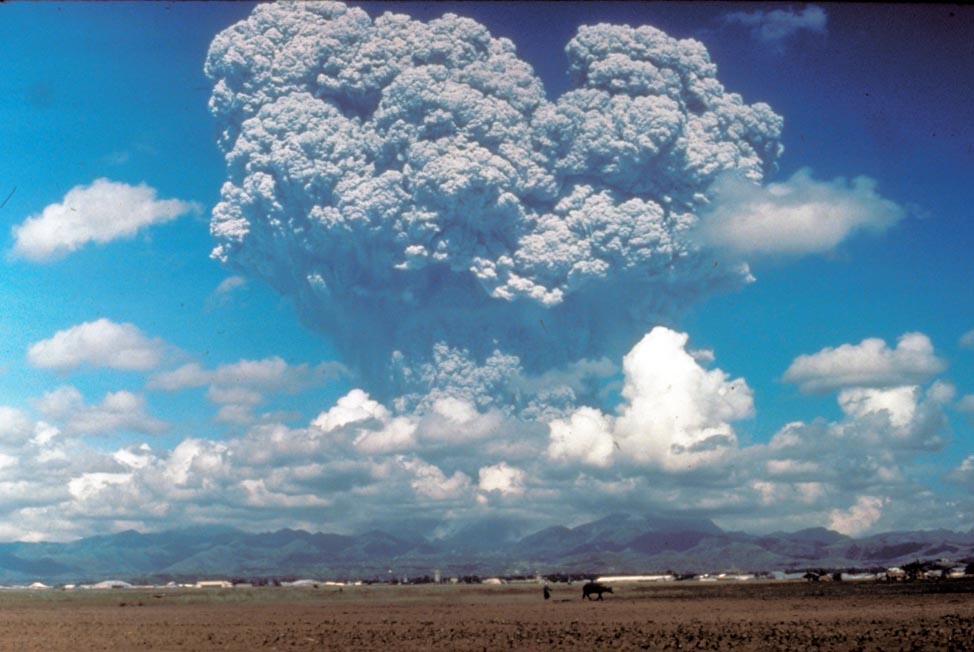
IMG0006.PCD
Volcanic eruptions: A decreasing likelihood in a warming climate
Climate change can also be expected to reduce the likelihood of one type of global catastrophic risk event: the impacts of a massive volcanic eruption. A magnitude-seven “super-colossal” eruption with a Volcanic Explosivity Index of seven (VEI 7) occurred in 1815, when the Indonesian volcano Tambora erupted. (The Volcanic Explosivity Index is a logarithmic scale like the Richter scale used to rate earthquakes, so a magnitude 7 eruption would eject ten times more material than a magnitude 6 eruptions like that of Mt. Pinatubo in the Philippines in 1991.)
The sulfur pumped by Tambora’s eruption into the stratosphere dimmed sunlight so extensively that Northern Hemisphere temperatures fell by about 0.4-0.7 degree Celsius(0.7-1.0°F) for 1-2 years afterward. The result: the famed Year Without a Summer in 1816. Killing frosts and snow storms in May and June 1816 in Eastern Canada and New England caused widespread crop failures, and lake and river ice were observed as far south as Pennsylvania in July and August. Famine and food shortages rocked the world.
Verosub (2011) estimated that future eruptions capable of causing “volcanic winter” effects severe enough to depress global temperatures and trigger widespread crop failures for one to two years afterwards should occur about once every 200-300 years, which translates to a 10-14% chance over a 30-year period. An eruption today like the Tambora event of 1815 would challenge global food supplies already stretched thin by rising population, decreased water availability, and conversion of cropland to grow biofuels.
However, society’s vulnerability to major volcanic eruptions is less than it was, since the globe has warmed significantly in the past 200 years. The famines from the eruption of 1815 occurred during the Little Ice Age, when global temperatures were about 0.9 degree Celsius (1.6°F) cooler than today, so crop failures from a Tambora-scale eruption would be less widespread than is the case with current global temperatures. Fifty years from now, when global temperatures may be another 0.5 degree Celsius warmer, a magnitude seven eruption should be able to cool the climate only to 1980s levels. However, severe impacts to food supplies still would result, since major volcanic eruptions cause significant drought. (To illustrate, in the wake of the 1991 climate-cooling VEI 6 eruption of the Philippines’ Mt. Pinatubo, land areas of the globe in 1992 experienced their highest levels of drought for any year of the 1950-2000 period.)
Unfortunately, the future risk of a volcanic global catastrophic risk event may be increasing from causes unrelated to climate change, because of the increasing amount of critical infrastructure being located next to seven known volcanic hot spots, argued Mani et al. in a 2021 paper, “Global catastrophic risk from lower magnitude volcanic eruptions.” For example, a future VEI 6 eruption of Washington’s Mount Rainier could cost more than $7 trillion over a 5-year period because of air traffic disruptions; similarly, a VEI 6 eruption of Indonesia’s Mount Merapi could cost more than $2.5 trillion.
Complex systems like human cultures are resilient, but are also chaotic and unstable, and vulnerable to sudden collapse when multiple shocks occur. Jared Diamond’s provocative 2005 book, Collapse: How Societies Choose to Fail or Succeed, described flourishing civilizations or cultures that eventually collapsed, like the Greenland Norse, Maya, Anasazi, and Easter Islanders. Environmental problems like deforestation, soil problems, and water availability were shown to be a key factor in many of these collapses.
“One of the main lessons to be learned from the collapses of the Maya, Anasazi, Easter Islanders, and those other past societies,” Diamond wrote, “is that a society’s steep decline may begin only a decade or two after the society reaches its peak numbers, wealth, and power. … The reason is simple: maximum population, wealth, resource consumption, and waste production mean maximum environmental impact, approaching the limit where impact outstrips resources.”
Some of Diamond’s conclusions, however, have been challenged by anthropologists. For example, the 2010 book, Questioning Collapse: Human Resilience, Ecological Vulnerability, and the Aftermath of Empire, argued that societies are resilient and have a long history of adapting to, and recovering from, climate change-induced collapses. But a 2021 paper by Beard et al., “Assessing Climate Change’s Contribution to Global Catastrophic Risk,” argued, pointed to “reasons to be skeptical that such resilience can be easily extrapolated into the future. First, the relatively stable context of the Holocene, with well-functioning, resilient ecosystems, has greatly assisted recovery, while anthropogenic climate change is more rapid, pervasive, global, and severe.”
To paraphrase, one can think of the nine planetary boundaries as credit cards, six of those nine credit cards charged to the hilt to develop civilization as it now exists. But Mother Nature is an unforgiving lender, and there is precious little credit available to help avoid a cascade of interconnected global catastrophic risk events that might send human society into total collapse, if society unwisely continues its business-as-usual approach.
Avoiding climate change-induced global catastrophic risk events is of urgent importance, and the UN report is filled with promising approaches that can help. For example, it explains how systemic risk in food systems from rainfall variability in the Middle East can be reduced using traditional and indigenous dryland management practices involving rotational grazing and access to reserves in the dry season. More generally, the encouraging clean energy revolution now under way globally needs to be accelerated. And humanity must do its utmost to pay back the loans taken from the Bank of Gaia, stop burning fossil fuels and polluting the environment, and restoring degraded ecosystems. If we do not, the planet that sustains us will no longer be able to.
Bob Henson contributed to this post.


Other news from the climate, environment front, if it hasn’t been reported here on NC.
James Lovelock, the father of the Gaia hypothesis, died on July 26th, his birthday, 103 years old.
From the Guardian obituary:
His Gaia hypothesis posits that life on Earth is a self-regulating community of organisms interacting with each other and their surroundings. He said two years ago that the biosphere was in the last 1% of its life.
And now, on that cheery note, here’s Tom with the weather (a Bill Hicks bit.)
Of course, he could also see that certain of those organisms were putting it’s thumb on the scale of self-regulation. The planet has never been self-regulating. Over billions of years natural systems (ecology) enter extended states of interactive balance that can be perturbed to the benefit of some elements and detriment to others. (See: Dinosaurs—and likely Homo’s)
I can’t speak for him but I’m pretty sure he’s aware of species putting their thumbs on the scale of self regulation, to use that phrase. His inventions made it possible to detect the extent of man made pollution, including detecting the damage fluorocarbons were doing to the ozone. He was also an inspiration for Rachel Carson’s The Silent Spring.
His prognosis for humanity isn’t particularly rosy. He stayed that the 21st Century will see a great culling of the human population, from the projected peak of ten, eleven billion to less than a billion.
The Overclass hopes to see the non-Overclass culled.
I would like to see the Overclass culled first and hardest, and then all the Upper Classes culled after that, and then all their Head Butlers ( bankers, lawyers, financial advisers, fund managers, etc.) culled after that.
Is there anything that Us Little People can do to direct the culling against the people and classes who deserve it first, worst and most?
What you call the overclass is mostly parasitic, and “culling” them (I’d prefer “making them so poor they have to get jobs”) would be largely beneficial.
The “Upper Classes” and “Head Butlers” are a more difficult problem. They have arrogated to themselves a lot of functions that will still have to be done by somebody somehow even after the “culling”. I hope that most will be amenable to a class arrangement that lets them continue whatever important things they do as equals rather than masters. Otherwise the transition could be very rocky.
Well, you raise a good point.
In a Perfect Beautiful World Future, the Lower Class in Revolt would be so well organized, and would have the Private Armies of the Rich so totally on the Lower Class Side; that they could make a visible point of killing all the Overclass people starting with the very toppest and going down the ladder one by one, and family by family.
And keep going down the ladder in hopes that eventually the Head Butlers will all start screaming ” We surrender! We surrender!” And then let them perform beneficial functions at a normal working-middle class level of pay and/or support.
If you want a job done well…
The Gaia hypothesis is reductionism masquerading as complexity. It’s similar to that guy who claims conciousness is an irreducible foundational element of the universe, because he doesn’t want to deal with the messy business of complex systems theory and emergent properties that are greater than the sum of the raw inputs.
Its also an effort to create a New Religion for people who feel the Old Religions have let them down.
” All hail Gaia Athena, the Mother Earth Mother self-regulating Planet Goddess on whose skin we live.”
There have been numerous warnings about the risks of climate change, mass extinctions, biosphere degradations. And yet, there have also been numerous calls for increased economic growth as a solution to poverty. We can’t have both, unless one believes that the Ministry For The Future will lead us all to the promised land. I’m not in that camp. We are all screwed. Lock and load. If you’ve got ’em smoke ’em.
I’m sure how to start. I know increased CO2 in the atmosphere is taken up in the oceans leading to ocean acidification in many areas. I know the climate in my area is warmer in winter than it used to be, and that weather seems more erratic than when I was younger. Maybe climate ‘disruption’ is a good description.
However, (you knew there’d be a ‘however’), I think much of what I read in the MSM is promoted by the ultra-wealthy to forward their money making schemes, which have nothing to do with changing climate pollutions. It has to do only with scaring everyone into thinking “there is no alternative” to the billionaire scaremongers’ “solutions”. Money in politics buys the billionaire class the political responses that enrich the billionaire class. No surprise. I’ve reached the opinion that anything promoted in the MSM or by the govt to a problem is not really about addressing the problem in the best way; it’s about making billionaires and global corporations much richer in the most effective way. I think it’s called “greenwashing”. /sigh
adding: Greta Thunberg is WEF. Of course she it.
https://www.weforum.org/agenda/authors/greta-thunberg
I”m not sure if you’re hedging about the role of greenhouse gases in climate change, but otherwise, I’d agree with you, flora.
That WEF types have, in their usual fashion, concocted fifty fake but fabulously money-making (for them) solutions, doesn’t mean that the problem isn’t real or critically in need of action. If the WEF types are able to so focus us on nothing more than their numerous diabolical schemes, they will have succeeded in distracting us from the very urgent need to address the problem seriously and immediately. While we’re squinting to discern the shape of their various conspiracies, we’re ignoring that the Doomsday clock is clicking away.
And that’s as true of Covid as climate policy.
I’m not hedging. See I made a typo in the first sentence. Should read “I’m *not* sure where to start.” Apologies for the confusion.
adding: we do have a problem. I’ve learned to ignore the carpetbaggers and their pet politicians, and look elsewhere for good ideas.
Perhaps a contrarian rule of thumb for solution-effectiveness and targetting-correctness might be . . . . does it materially hurt one or more people who are in any way WEF-connected? If it does, then it is good in itself and it may be part of a genuine global-dewarming suite of actions.
The main stream media are not the only concern. Science itself has become a handmaid to the Market.
The Market – $cience department. Neoliberal $cience. See Mirowski about neoliberal ideology suborning science and scientists to the profit motive.
Riffing off that theme — the Market — I am deeply disturbed by how much discussion of Climate Chaos is couched in Market jargon and measures in dollar costs. The Market would sell us the rope to hang ourselves with. Climate Chaos is an existential concern. I know of no dollar measure that can appraise the value I place on my own life or the lives of my children, my friends, acquaintances, and all the billions of strangers my imagination can embrace, or the many billions of other lives of the animals and plants on this beautiful blue planet. Yet the earliest efforts to grasp the crisis we face lead to calculations of Carbon budget and Charney’s CO2 sensitivity coefficient. An email I received from James Hansen’s email push advocates “carbon tax and 100% dividend (name changed to “fee and dividend” months later)” and “A rising carbon fee is the essential requirement to solve the climate ” — Market speak!
There are these two young fish swimming along, and they happen to meet an older fish swimming the other way, who nods at them and says, “Morning, boys, how’s the water?” And the two young fish swim on for a bit, and then eventually one of them looks over at the other and goes, “What the hell is water?”
We swim in the water of the Neoliberal Market — its frame — its terminology, its premises, axioms, and assumptions … and this is evident in even what passes for Climate Science and the environmental movement. The Market will not and can not cut the Gordian Knot of Climate Chaos. Climate Chaos has nothing to do with costs, optimizations, or Market ‘computations’ of the Pareto Optimal! Climate Chaos is a vital threat to the very existence of Humankind.
FUN BREAK: Fun project and possible gift idea — look for triple pendulum fidget toys designed to demonstrate the workings of chaos in even a relatively simple mechanical system. Then contemplate the climate systems, even climate systems such as we currently understand them [I believe there are many interesting effects yet to be discovered.]
Here is a link to John Bellamy Foster’s piece on the financialization of the Earth. https://monthlyreview.org/2022/04/01/the-defense-of-nature-resisting-the-financializaton-of-the-earth/
The current issue of Monthly Review is devoted to the ecological crisis. Excellellenr Neo-Marxian analysis. Don’t think they’ve quite come to grips with the reality of the “Jackpot,” but still excellent stuff!
The problem with such schemes is we, as a country, have never really used market incentives when it comes to the environment. We have always preferred mandates (e.g. unleaded gasoline, catalytic converters, etc.).
We don’t need market incentives if we know what we need to do by what time. Economists fret that mandates are horribly “inefficient” but actually, so are carbon taxes and cap & trade if you don’t set the tax or auction parameters just right. Advocates of market-based solutions, I fear, are either naive (that it won’t be gamed) or disingenuous (knowing it will be gamed).
The Paris accords establishes a framework for specific, quantitative reductions in emissions over time. But this isn’t a mandate. It’s voluntary. As such it’s just PR. A mandate comes with verification and enforcement–police, fines, prison…..
There is still non-profit sound science being done here and there.
It is time for Albrecht Durer to make a return engagement to enhance his woodcut of the four horsemen. I guess it was decided that four is too few considering the tremendous increase in human population since Durer’s era. Of course it will be difficult to select the horsemen additions given the many contenders and the artistic needs of a pleasing visual composition.
The author of this post needs to share whatever secret palliative fuels optimism like that in the last paragraph:
“More generally, the encouraging clean energy revolution now under way globally needs to be accelerated. And humanity must do its utmost to pay back the loans taken from the Bank of Gaia, stop burning fossil fuels and polluting the environment, and restoring degraded ecosystems. If we do not, the planet that sustains us will no longer be able to.”
Does the author really think any of this has any chance of happening given the kind of governments and political economy Humankind enjoys in the present?
What if it’s all true? I think It is. I differ from Mr. Masters about volcanos/earthquakes. A rotating sphere (the earth) must be finely balances to remain stable. Could the redistribución of mass due to loss of ice at the poles affect this equilibrium? The rate of change in magnetic north is increasing. Could the earth’s crust, the techtonic pilates, undergo somé adjustments? Any geologists in the room?
Yes there is a link.
I thought it was strange to say volcanism risk decreased but then he went on to basically say that the earth will be so hot that even large drops in temps won’t be catastrophic. I don’t buy that either since atmospheric patterns change so much, droughts and floods will still do tons of damage, perhaps more due to general atmospheric changes.
The article said volcanoes would be less of a risk, not no risk. As the article says Mt Rainer going of would still do a lot of damage.
As the earth warms the risk of nuclear winter or volcanic winter or meteorite winter decreases. However I am sure a big one of any of those would still be plenty to cause a mass extinction event.
RIP James Lovelock. Gaia will probably need about 10 million years to clean up the mess from the Homo Colossus party. Those 400 nuclear power plants won’t do it themselves.
It’s a shame the two legs have to take so many other sentients with them.
It’s beginning to appear that collectively humans are not smarter than yeast.
There are sub-collective little groups of humans who have always been smarter than yeast. Perhaps they are even now making silent preparations to outlast the Yeast Majority and withhold their eco-survival knowledge from Yeast-Majority persons.
Thanks for this excellent summary!
Reading this catalog of risks (likelihoods and consequences) makes me reflect on the “most important number you’ve never heard of” — the “Social Cost of Carbon (SCC)”. This number attempts to capture, in dollars per ton CO2, the total social cost (externality) of emitting, at the margin, the next ton of carbon into the atmosphere. Obama had a team of economists try to calculate it, and they came up with around $50/ton CO2. Joe Biden’s proposed re-do of this excercise, using stochastic methods, has been delayed by the courts and political jousting. Stiglitz in early 2021 came out with an excellent paper that suggested it needed to be more–probably much more– than $100/ton.
Here’s the thing: the most sensitive parameter in calculating SCC is the discount rate. Economists don’t agree on how to objectively estimate a 100-year discount rate. Then you have other problems, including the “damage” probability distribution over time, correlation of the uncertain variables, the confidence level, and much besides.
Reading this summary, my guess is that, by now, the SCC for all practical purposes is probably infinite, particularly when you factor in risk and risk aversion. That means the SCC will probably never get modeled/calculated because it will be criticized by one and all as either too low or too high.
We are too scared of a number to consider the implications and rightly so. If we took it seriously, we’d have to change the whole basis of our economy, our foreign relations, you name it. We’d actually have to think about a Green New Deal x 10 to fight a common enemy–us–and stop putting so much of the social surplus into fighting wars.
I was a bit surprised to see “High Energy Physics Experiments” listed as a possible Global Catastrophic Risk. What sort of thing could happen beyond destroying the elaborate machinery needed to conduct such experments?
I remember reading/hearing that when the Very Largest UltraSuper Large Hadron Collider was set to be turned on, some people said ” what if it produces a tiny black hole which grows to swallow up the earth”?
The Scienticians In Charge all said variations of ” oh, that can’t happen” and/or ” so what if it does?”
It is not correct to say that absorbing CO2 makes the oceans “more acidic”. To become “more acidic” they must already be acidic and that is not the case. I still believe that language matters.
More importantly, the article fails to note that salt water’s capacity to hold CO2 decreases as it warms. So ceteris paribus the oceans will expel CO2 and become more alkaline as they warm. It is just one of the earth’s great stabilizers and a genuine discussion of “ocean acidification” should note the opposing processes.
I’ve never understood how the American left can’t see the big picture when it comes to climate change. The mantra seems to be to cut consumption to reduce emissions and everything will fall into place. There is no discussion of what cutting “consumption” really means. Does anyone seriously expect the energy producing countries to willingly leave countless trillions of dollars of energy in the ground? Or oil companies, pension funds, and wealthy elites to give up their money (these people won’t even give up private jets) Or employees of oil and mining companies, cattle companies, and travel industries to willingly give up their jobs? Or citizens of the U.S. (14% of CO2 emissions), China (31% of CO2 emissions), Europe (9% of CO2 emissions) and other countries willingly choose a 3rd world lifestyle? There is a big picture and the consumption side isn’t going to happen in the amount necessary to make a real difference. Perhaps technology will be a solution. The certain solution will be a hot world for eons that will kill off civilization along with 90% of the lifeforms on the planet. If humans don’t come up with something you can be certain that nature has a solution.
Technology may not save us when you see the larger picture and realize that our modern technological progress was a by product of having a great energy surplus since the mass production of coal 2 centuries ago. Also there’s a well documented phenomenon called the jevons paradox which says gains in efficiency doesn’t save on consumption but instead makes consumption more efficient.
A tech fix is only a possibility, not remotely a probability. The much more likely outcome over the coming decades is a slow collapse of civilization followed by a rapid collapse. It would surprise me if there is a United States in its current configuration by the end of the century.